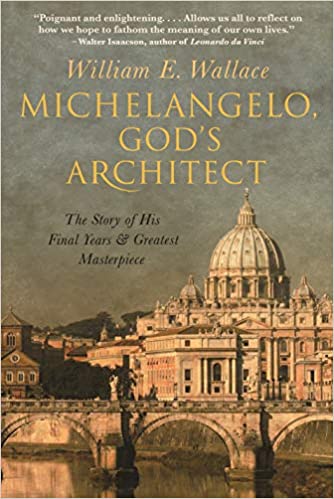
Michelangelo and Me
By: Norman J. Olson
I am almost finished with a new biography of Michelangelo by distinguished art historian William E. Wallace… this book is, as the cover blurb suggests, “a good read”… a book that discusses this fascinating and complex artist by carefully considering his own words, the views of his contemporaries and the historical context of his life and times… Michelangelo was a prolific letter writer as well as a poet… especially in his later years… and this book looks carefully at his letters to give the reader a look behind the veil, so to speak of the artist’s public persona to give us a glimpse of the private man…
Michelangelo saw himself as an aristocrat, tracing his ancestry back to the Medieval Counts of Canossa… modern scholars are skeptical about this link but, of course, the modern student of art could care less if Michelangelo was of aristocratic lineage… but for the artist himself, his being of noble lineage was a massive part of his self image and to some extent, the reason he was able to so completely transcend the simple business arrangement, to for example decorate the ceiling of a chapel… Michelangelo’s view of himself as an aristocrat put him on a different footing than other renaissance artists in that he did not see himself as a hired hand doing a piece of work for a fee… even though that is what he ultimately was… in this sense, he was much more like a modern artist doing art for personal reasons and only being paid as a sort of courtesy… whereas the typical renaissance artist produced pictures to order for a client… Michelangelo agonized over art not to please a patron, but to please himself… his aristocratic self…
Michelangelo was by most accounts, a surly and difficult person to deal with… he was easily offended and thin skinned… he did not worry much about his personal hygiene, famously wearing his boots to sleep in for weeks at a time so that when he finally took them off, a layer of dried skin came off with them… he loved his work and spent long hours carving marble, painting and drawing… he was also a talented architect who was able to organized a building project… when he took over as architect of St. Peter’s, he was an old man, but still, he took over a building project rife with corrupt suppliers, do nothing workers, mismanagement and poor design… he redid the design, had the work crews disassemble much unnecessary building that had been added on to the original design and then redid the design… the design he inherited was poorly engineered, so he had to reengineer the building so that it would not collapse and then he redesigned the dome… he hired managers, stone carvers, mule drivers, wagoneers, blacksmiths, rope workers, etc… and saw to it that the work was carried out to his design efficiently and using the best materials obtainable… so not only was Michelangelo able to draw, paint and sculpt as no other had ever done, he was a genius for organizing and building…
Michelangelo’s family was large and almost totally dependent on him… he supported his siblings and his aging father and worked hard to see that his family was able to keep up the appearance of their aristocratic lineage… with nice houses etc… he set his brothers up in businesses and farms and his letters are full of his instructions to them about buying property and investing the money he sent them… from the letters, they seem like kind of an annoying bunch… but even as an old man, he was constantly writing back and forth with them…
the book makes much of Michelangelo’s friends… in fact, he had a number of close friends who did not see the surly and difficult artist but rather the guy who was a witty dinner guest… as he grew older, he wrote poetry which he often sent to his poet friends for proofing and correcting… and his poetry is surprisingly modern in that it is about himself and his struggles with art, and very confessional, as so much modern poetry is… he was sincerely religious, especially as he grew older… according to Wallace, Michelangelo was a pretty good poet and would have been more known except that the plan to publish a book of his verse fell apart when the friend who was helping with the project died…
anyway, a few years ago, I was in Rome… I visited the Sistine Chapel which I had not seen in about 40 years… it is an amazing experience to walk through the door into that space and see those amazing paintings on the ceiling 130 feet overhead… the figures so amazingly painted on that ceiling are so much more than the bible stories they illustrate… in fact, I find it more interesting to look at the paintings as figures and fabrics… I love the way the bodies are portrayed, the gigantic muscular men in all their writhing poses and the swirling of multicolored robes emerging from shadow… for me, seeing that art work is a life galvanizing event… I have studied and looked at pictures of this art all my life, but seeing the originals in all their size and glory is truly amazing…
I also have made the trek to San Pietro in Vincoli church, up the hill from the coliseum in Rome to see Michelangelo’s masterpiece carving in marble titled Moses… words fail me in describing this statue, but to me, it is a magnificent piece of art… and a story about it is that the Jewish community in Rome used to make pilgrimage to the Christian church to see this statue because it portrayed Moses… a major figure in the Hebrew religion…
I recently read a post from an artist of my acquaintance with a saying by somebody that a “provincial” artist is one who passively waits to be discovered… this post inspired a facebook discussion among the artist’s vast number artistic and intellectual “friends” about how to make sure one’s work is “discovered” and just what that means… it seems that the consensus was that being “discovered” meant obtaining an international reputation and that one had to hustle to do that by leaving Minnesota and going to New York, or someplace like it and getting your work in museums of modern art… having representation of an important gallery was the way to make this happen although, getting into the museums of modern art was agree to be tough, because as one person said, the museums are running out of storage space… but, if you do not get discovered or at least try by selling art, you are an amateur or even worse, a hobbyist and in any case, hopelessly provincial…
well, Michelangelo certainly had and has, an international reputation so, I guess we must qualify him as “discovered…” so, does that mean that I, as an artist who likes Michelangelo and considers myself to be a serious artist should try to be discovered? or what? I will be forever provincial, an amateur and a hobbyist… geeze… what a conundrum… oh well, fortunately, I have my small press audience and although I am not an aristocrat, I also am not Michelangelo…

William Wallace’s history Michelangelo: God’s Architect is available here.
